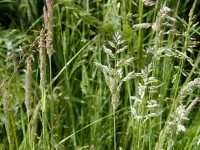How grasslands respond to climate change
Effects of CO2 increase were already apparent in the past century
2021-03-24
(Press-News.org) "Based on field experiments with increased carbon dioxide concentration, artificial warming, and modified water supply, scientists understand quite well how future climate change will affect grassland vegetation. Such knowledge is largely missing for effects that already occurred in the last century," says Hans Schnyder, Professor of Grassland at the TUM.
Based on the Park Grass Experiment at Rothamsted, researchers have now shown that future predicted effects of climate change on the nutrient status of grassland vegetation have already taken hold in the last century.
Plant intrinsic mechanisms respond to CO2 increase
Since 1856, research at Rothamsted has been testing the effects of different fertilizer applications on yield performance and botanical composition of hay meadows. Harvested material has been archived since the experiment began. This material is now available to researchers for studies of vegetation nutrient status, and the carbon and oxygen isotope composition of biomass.
"The increase in atmospheric CO2 concentration also affect the carbon, water, and nitrogen cycles in grasslands as well as other biomes," says Professor Schnyder. The mechanism that controls gas exchange with ambient air (the stomatal conductance of the plant canopy) is a key player in these cycles.
Plants control how far their stomata, small pores in the leaf epidermis, open to optimize the balance between carbon dioxide uptake (photosynthesis) and water loss (transpiration). With increased CO2 exposure, they reduce stomatal aperture to save water. This effect is particularly efficient in grasses. However, a reduction in transpiration leads to a reduced mass flow from the soil to the roots and leaves, which can result in reduced nitrogen uptake and feed back to weaken photosynthetic capacity.
Yield reduction and deterioration of the nitrogen nutrition status
Combining the new analyses of oxygen and carbon isotope composition, nitrogen and phosphorus in biomass, and yield and climate data, the research team, led by Professor Schnyder, analyzed the physiological effects of the emission-related increase in CO2 concentration (about 30%) and associated past climate change.
They found that in particular the grass-rich communities that were heavily fertilized with nitrogen experienced a deterioration in their nitrogen nutrition status. Climate change also resulted in greatly reduced stomatal conductance (now detectable with the new research methods) and significantly reduced yields.
The core element of the researchers' observations is the hypersensitive CO2 response of stomata in grasses which they believe limits transpiration-driven nitrogen uptake.
Nitrogen fertilization has no positive effects on grassland yield performance
"We also observed that fields that were heavily fertilized with nitrogen, and therefore rich in grass, largely lost their yield superiority over forbs- and legume-rich fields that were either less or completely unfertilized with nitrogen despite being otherwise equally supplied with nutrients over the course of the last century," says the first author of the study Juan Baca Cabrera, who is pursuing a doctorate at the TUM's chair of Grassland.
In the researchers' view, the results indicate that restraining nitrogen supply to grasslands in the future would enhance the yield contribution from forbs and legumes while at the same time would help limit nitrogen emissions to the environment. Professor Schnyder states, "Our findings are important for understanding the importance of grasses in earth systems and provide guidance for sustainable future grassland use."
INFORMATION:
[Attachments] See images for this press release:

ELSE PRESS RELEASES FROM THIS DATE:
2021-03-24
A new view of the region closest to the supermassive black hole at the center of the galaxy Messier 87 (M87) has shown important details of the magnetic fields close to the black hole and hints about how powerful jets of material can originate in that region.
A worldwide team of astronomers using the Event Horizon Telescope, a collection of eight telescopes, including the Atacama Large Millimeter/submillimeter Array (ALMA) in Chile, measured a signature of magnetic fields -- called polarization -- around the black hole. Polarization is the orientation of the electric fields in light and radio waves and it can ...
2021-03-24
It all started when litter researchers found a perch in the canals of Leiden that had become caught up in a latex glove. As far as we know, this was the first Dutch victim of corona waste. Since then, they have been trying to obtain an overall picture of the consequences of the corona waste mountain on animals.
Biologists Auke-Florian Hiemstra from Naturalis Biodiversity Center and Liselotte Rambonnet from Leiden University started a quest to determine how often and where interactions between corona waste and animals occur. They collected observations from Brazil to Malaysia and from social media to local newspapers and international news websites. A fox in the United Kingdom, birds in Canada, hedgehogs, ...
2021-03-24
Neurodevelopmental disorders like autism and schizophrenia disproportionately affect males and are directly linked to early life adversity caused by maternal stress and other factors, which might be impacted by nutrition. But the underlying reasons for these male-specific impacts are not well understood. Researchers from the University of Missouri School of Medicine and the MU Thompson Center for Autism and Neurodevelopmental Disorders have uncovered possible reasons for male vulnerability in the womb, and they've learned a specific maternal dietary supplement called docosahexanoic acid (DHA) may guard against the impact of maternal stress on unborn males during early development.
"We believe differences in metabolic requirements for male ...
2021-03-24
The more colorful a food, the more nutritious it probably is. For example, purple corn contains compounds associated with a reduced risk of developing diabetes and heart disease. The cobs contain the same compounds but are typically thrown out. Now, researchers report a step-wise biorefinery approach in ACS Sustainable Chemistry & Engineering that uses the whole cob, producing a dye and a possible nutraceutical with the pigments, and an animal litter with the left-overs.
Eating a rainbow of fruits and vegetables provides a variety of health benefits, with vitamins and nutrients ...
2021-03-24
Since the early industrial revolution in the mid-1700s, fossil fuels have acquired an ever-growing footprint in energy production. However, the environmental concerns of fossil fuels use and their inevitable depletion have led to a global shift toward renewable energy sources. These transitions, however, raise questions about the best choice of renewables and the impact of investing in these resources on consumer cost.
In a recent study published in the journal Nature Communications, researchers at Texas A&M University have devised a metric that reflects the average price of energy in ...
2021-03-24
The unprecedented rainfall from Hurricane Harvey in 2017 brought more than flood damage to southeast Texas. For people living in environmental justice communities such as the Manchester neighborhood near the Houston Ship Channel, heavy rainfall and flooding may have increased risks of exposure to harmful chemicals from nearby industry.
To gain a better understanding of how flooding mobilized pollution in the area, a research team led by Garett Sansom, DrPH, research assistant professor in the Department of Environmental and Occupational Health at the Texas A&M University School of ...
2021-03-24
umans are remarkably adaptable, and our ancestors have survived challenges like the changing climate in the past. Now, research is providing insight into how people who lived over 5,000 years ago managed to adapt.
Madelynn von Baeyer Ph.D. '18, now at the Max Planck Institute for the Science of Human History, UConn Associate Professor of Anthropology Alexia Smith, and Professor Sharon Steadman from The State University of New York College at Cortland recently published a paper in the Journal of Archaeological Science: Reports looking at how people living in what is now Turkey adapted agricultural practices to survive as conditions became more arid.
The work was conducted ...
2021-03-24
March 24, 2021 - With heavy workloads and high professional and personal demands, medical residents in training - and those in urology residency programs - face a high risk of burnout. At one urology department, a wellness program designed by and for residents produced meaningful reductions in burnout risks, reports a study in Urology Practice®, an Official Journal of the American Urological Association (AUA). The journal is published in the Lippincott portfolio by Wolters Kluwer.
The Resident Wellness Curriculum (RWC) in the Scott Department of Urology at Baylor College of Medicine, Houston, led to significant improvements in key aspects of burnout, according to the new research by Jennifer M. Taylor, MD, and colleagues. ...
2021-03-24
Researchers at the Perelman School of Medicine at the University of Pennsylvania have produced a detailed molecular atlas of lung development, which is expected to be a fundamental reference in future studies of mammalian biology and of new treatments for diseases, such as COVID-19, that affect the lungs.
The researchers, who published their study in Science, generated a broad atlas of cell types in the developing and adult mouse lung by measuring the expression of genes in thousands of individual mouse lung cells across the lifespan, covering multiple cell types and ...
2021-03-24
Bone turnover markers, and specifically bone resorption markers, are commonly used to monitor patients' response to pharmacological treatment and adherence.
In 2011, the Joint Committee on Bone Marker Standards of the International Osteoporosis Foundation (IOF) and the International Federation of Clinical Chemistry and Laboratory Medicine (IFCC) designated Procollagen type I N-propeptide (PINP) and the C-terminal telopeptide of type I collagen (ß-CTX) in blood as reference bone turnover markers for bone formation and bone resorption, respectively, in osteoporosis. ...
LAST 30 PRESS RELEASES:
[Press-News.org] How grasslands respond to climate change
Effects of CO2 increase were already apparent in the past century




